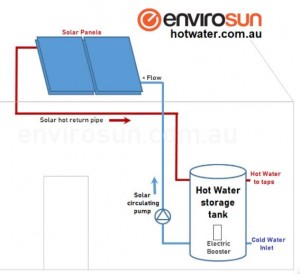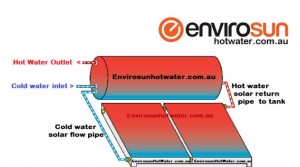Many people want to look at ways they can make their home more economical and environmentally friendly, and one way to do that is to focus on energy usage. Solar panels are a great source of energy into your home, and while the basics are easy to understand, some of the processes such as the solar hot water system can be a little harder to understand and comprehend. There are many different elements to consider, and it is worth noting that a solar hot water system may need some additional help within the process, which we discuss later on in terms of the time of year and energy usage. But we hope this will give you the basics. With that in mind, here is a four point guide to help you understand the solar hot water system.
First of all, what is a solar hot water system?
Solar electric panels (also called solar cells or photovoltaic cells) are used to convert sunlight to electricity. They have only just in recent times started to gain popularity. Whereas, solar thermal panels, which use sunlight to produce hot water, have been commonplace for decades and are proving to be very popular as a solar hot water system. Even in relatively cold or northern climates, solar hot water systems can chop significant amounts off your energy bills. Typical systems generate anything from 70–90 percent of your hot water and pay for themselves in about 5 years. It can be a great investment for your eco-focused home and alongside other solar panel usage for things like energy, a worthy addition to your home.
How does it work?
When it comes to efficiency, solar-thermal panels are over three times as efficient, at harvesting energy as solar-electric panels. If you live in the kind of family home where people are taking baths and showers all the time, especially in summer, solar thermal makes perfect sense to you as an eco friendly alternative. A decent system should be able to produce around half to two thirds of a home’s total, annual hot water needs. So now onto the main concept of this article. How do solar hot water systems operate. Here is a four point guide to help you understand this better.
Heating
Sun heats water flowing in a circuit through the collector (the panel on your roof). There are two different types of collector, a flat plate collector and evacuated tubes. The water leaving the collector is hotter than the water entering it and carries its heat to the hot water tank. The hot water rises to the top of the tank.
If we look at the diagram of a split system, colder water is pumped via a circulation pump from the bottom of the tank and returned back to the solar collector. The water is stored in the storage tank ready for use.
In a thermosiphon installation where the tank sits on the roof above the collectors as shown in the diagram, the cold water will flow naturally into the collector because it is heavier than hot water. The water is stored in the storage tank ready for use.
What about when I need hot water?
You can run your hot water taps at any stage and this will not affect the heating process. When you use the hot water, the water is taken from the top of the tank as this is where the water is the hottest. However, the panel won’t be heating your water all of the time, so you may need to consider an alternative source to heating in those overcast and rainy days such as a gas or electric booster backup. A solar thermal panel for your hot water system is ideal for heavy hot water usage as it can create up to half of your hot water take through ecological means.
How does the water keep circulating?
The water is sent through the process of pipes from your water tank to your storage tank. But for this to be effective for a ground mounted tank installation, or split system installation, you use an electric pump that helps circulate the water around the hot water system.
What about during the winter?
What if it’s winter and there’s no useful solar heat outside? You don’t want the solar system pumping cold water down into your home, but you still need hot water, right? You’ll most likely need to boost during the colder months. The most common type of backup is an electrical booster. Turning the booster on will mean electricity will boost the temperature of the hot water in your tank. You can turn the booster on at anytime of the day or night, but it will only boost when the tariff is on. For example, most solar hot water systems should run on Tariff 33 which is an off peak tariff. Therefore, the system will not boost during peak times, only at off peak times.
Let’s hope this helps you when it comes to understanding your solar hot water system.
